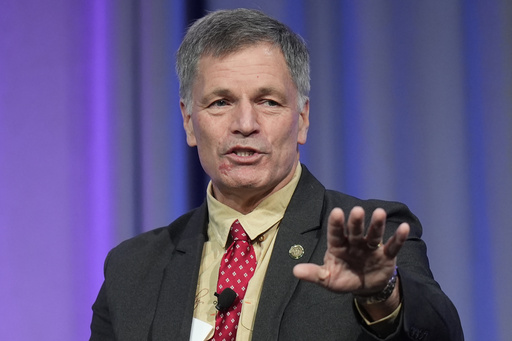CHEYENNE, Wyo.
By MEAD GRUVER and MATT O’BRIENAssociated Press
A massive AI data center proposed near Cheyenne, Wyoming, would use more electricity than all homes in the state combined. Mayor Patrick Collins calls it a “game changer.” The center is a joint effort by Tallgrass and Crusoe. It will start at 1.8 gigawatts and could expand to 10 gigawatts. Wyoming is a top energy producer and exports most of its electricity. The center would have dedicated energy produced by renewables and by burning natural gas. Although OpenAI is searching for data center sites, a Crusoe spokesperson declined to confirm if this project is part of the OpenAI Stargate effort.
CHEYENNE, Wyo. (AP) — An artificial intelligence data center that would use more electricity than every home in Wyoming combined before expanding to as much as five times that size will be built soon near Cheyenne, according to the city's mayor.
“It’s a game changer. It’s huge,” Mayor Patrick Collins said Monday.
With cool weather — good for keeping computer temperatures down — and an abundance of inexpensive electricity from a top energy-producing state, Wyoming's capital has become a hub of computing power.
The city has been home to Microsoft data centers since 2012. An $800 million data center announced last year by Facebook parent company Meta Platforms is nearing completion, Collins said.
The latest data center, a joint effort between regional energy infrastructure company Tallgrass and AI data center developer Crusoe, would begin at 1.8 gigawatts of electricity and be scalable to 10 gigawatts, according to a joint company statement.
A gigawatt can power as many as 1 million homes. But that's more homes than Wyoming has people. The least populated state, Wyoming, has about 590,000 people.
And it's a major exporter of energy. A top producer of coal, oil and gas, Wyoming ranks behind only Texas, New Mexico and Pennsylvania as a top net energy-producing state, according to the U.S. Energy Information Administration.
Accounting for fossil fuels, Wyoming produces about 12 times more energy than it consumes. The state exports almost three-fifths of the electricity it produces, according to the EIA.
But this proposed data center is so big, it would have its own dedicated energy from gas generation and renewable sources, according to Collins and company officials.
Gov. Mark Gordon praised the project's value to the state's gas industry.
“This is exciting news for Wyoming and for Wyoming natural gas producers," Gordon said in the statement.
While data centers are energy-hungry, experts say companies can help reduce their effect on the climate by powering them with renewable energy rather than fossil fuels. Even so, electricity customers might see their bills increase as utilities plan for massive data projects on the grid.
The data center would be built several miles (kilometers) south of Cheyenne off U.S. 85 near the Colorado state line. State and local regulators would need to sign off on the project, but Collins was optimistic construction could begin soon.
"I believe their plans are to go sooner rather than later,” Collins said.
OpenAI, the developer of Chat GPT, has been scouring the U.S. for sites for a massive AI data center effort called Stargate, but a Crusoe spokesperson declined to say if the Cheyenne project was one.
“We are not at a stage that we are ready to announce our tenant there,” said the spokesperson, Andrew Schmitt. “I can’t confirm or deny that is going to be one of the stargate."
Recently, OpenAI announced it had switched on the first phase of a Crusoe-built data center complex in Abilene, Texas, in a partnership with software giant Oracle.
“To the best of our knowledge, it is the largest data center — we think of it as a campus — in the world,” OpenAI’s chief global affairs officer Chris Lehane told The Associated Press last week. “It generates, roughly and depending how you count, about a gigawatt of energy.”
OpenAI has also been looking elsewhere in the U.S. to expand its data centers. It said last week that it has entered into an agreement with Oracle to develop another 4.5 gigawatts of data center capacity.
“We’re now in a position where we have, in a really concrete way, identified over five gigawatts of energy that we’re going to be able to build around,” Lehane said.
OpenAI hasn’t named any locations, besides its flagship site in Texas, where it plans to build data centers.
As of earlier this year, Wyoming was not one of the 16 states where OpenAI said it was looking for locations to build new data centers.
___
O'Brien reported from Austin, Texas.


